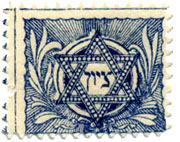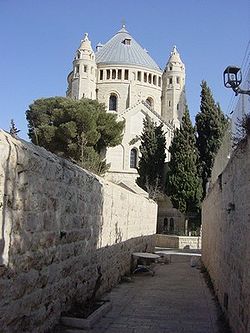Zion

Zion (
The name is found in
The term Tzion came to designate the area of Davidic Jerusalem where the Jebusite fortress stood, and was used as well as synecdoche for the entire city of Jerusalem; and later, when Solomon's Temple was built on the adjacent Mount Moriah (which, as a result, came to be known as the Temple Mount), the meanings of the term Tzion were further extended by synecdoche to the additional meanings of the Temple itself, the hill upon which the Temple stood, the entire city of Jerusalem, the entire biblical Land of Israel, and "the World to Come", the Jewish understanding of the afterlife.
Over many centuries, until as recently as the 16th century (Ottoman period), the city walls of Jerusalem were rebuilt many times in new locations, so that the particular hill known in biblical times as Mount Zion is no longer within the city walls, but its location is now just outside the Old City and southeast of it. Most of the original City of David itself is thus also outside the current "Old City" wall. Adding to the confusion, another ridge, the Western Hill rather than the original Southeastern Hill (City of David) or the Southern Hill (Temple Mount), has been called 'Mount Zion' for the last two millennia.
Etymology
The etymology of the word Zion (ṣiyyôn) is uncertain.[3][4][5]
Mentioned in the Old Testament in the
The form ציון (Tzion, Tiberian vocalization: Ṣiyyôn) appears 108 times in the Tanakh, and once with article, as HaTzion.[7][8]
Tsade is usually rendered as z in English translations, hence the spelling Zion (rather than Tzion). This convention originates in German orthography,[9] where z stands for the consonant [t͡s].
Judaism: religion and Zionism
Hebrew Bible: Zion, daughter(s) of Zion

Zion is mentioned 152 times in the Hebrew Bible (Tanakh), most often in the
Out of the 152 mentions, 26 instances are within the phrase of "Daughter of Zion" (Hebrew "bat Tzion"). This is a personification of the city of Jerusalem, or of its population.[10]
In
Psalm 147 uses "Jerusalem" and "Zion" interchangeably to address the faithful: "The Lord builds up Jerusalem; He gathers the outcasts of Israel. He heals the brokenhearted and binds up their wounds. His delight is not in the strength of the horse, nor his pleasure in the legs of a man, but the Lord takes pleasure in those who fear him, in those who hope in his steadfast love. Praise the Lord, O Jerusalem! Praise your God, O Zion!"
Religious practice; exegesis
The location of the Temple, and in particular its Holy of Holies (innermost sanctum), is the most holy place in the world for the Jewish people, seen as the connection between God and humanity. Observant Jews recite the Amidah three times a day facing the Temple Mount in Jerusalem, praying for the rebuilding of the Holy Temple, the restoration of the Temple service, the redemption of the world, and for the coming of the Messiah.[citation needed]
In Kabbalah,[dubious – discuss] the more esoteric reference is made to Tzion being the spiritual point from which reality emerges, located in the Holy of Holies of the First, Second and future Third Temple.[11][dubious – discuss]
Jewish–Roman wars
The name "Zion" appears in the coins minted by the revolutionary government in Jerusalem during the
Zionism

The term "
The last line of the Israeli national anthem Hatikvah (Hebrew for "The Hope") is "....Eretz Zion, ViYerushalayim", which means literally "The land of Zion and Jerusalem".
Islamic tradition
Ṣahyūn (
For example, the reference to the "precious cornerstone" of the new Jerusalem in the Book of Isaiah 28:16 is identified in Islamic scholarship as the Black Stone of the Kaaba.[19] This interpretation is said by ibn Qayyim al-Jawziyya (1292–1350) to have come from the People of the Book, though earlier Christian scholarship identifies the cornerstone with Jesus.[19]
Latter Day Saint
Within the Latter Day Saint movement, Zion is often used to connote a peaceful ideal society. In the Latter Day Saints belief system the term Zion is often used to denote a place of gathering for the saints. It is also often used to denote an area or city of refuge for the saints.
Rastafari movement
I say fly away home to Zion, fly away home...One bright morning when my work is over, man will fly away home...
— Rastaman Chant, Bob Marley and the Wailers
In Rastafari, "Zion" stands for a utopian place of unity, peace and freedom, as opposed to "Babylon", the oppressing and exploiting system of the materialistic modern world and a place of evil.[20]
It proclaims Zion, as reference to
Rastafari reggae contains many references to Zion; among the best-known examples are the Bob Marley songs "Zion Train", "Iron Lion Zion", the Bunny Wailer song "Rastaman" ("The Rasta come from Zion, Rastaman a Lion!"), The Melodians song "Rivers of Babylon" (based on Psalm 137, where the captivity of Babylon is contrasted with the freedom in Zion), the Bad Brains song "Leaving Babylon", the Damian Marley song featuring Nas "Road to Zion", The Abyssinians' "Forward Unto Zion" and Kiddus I's "Graduation in Zion", which is featured in the 1977 cult roots rock reggae film Rockers, and "Let's Go to Zion" by Winston Francis. Reggae groups such as Steel Pulse and Cocoa Tea also have many references to Zion in their various songs.
The Jewish longing for Zion, starting with the deportation and enslavement of Jews during the Babylonian captivity, was adopted as a metaphor by Christian black slaves in the United States.[citation needed][year needed] Thus, Zion symbolizes a longing by wandering peoples for a safe homeland. This could be an actual place such as
The Bahá’í Faith
References to Zion occur in the writings of the Bahá’í Faith. Bahá’u’lláh, the prophet-founder of the Bahá’í Faith wrote, concerning the Bahá’í Revelation,
The time foreordained unto the peoples and kindreds of the earth is now come. The promises of God, as recorded in the holy Scriptures, have all been fulfilled. Out of Zion hath gone forth the Law of God, and Jerusalem, and the hills and land thereof, are filled with the glory of His Revelation.
— Bahá’u’lláh, Gleanings from the Writings of Bahá’u’lláh[23]
Call out to Zion, O Carmel, and announce the joyful tidings: He that was hidden from mortal eyes is come! His all-conquering sovereignty is manifest; His all-encompassing splendor is revealed.
— Bahá’u’lláh, Tablet of Carmel, Tablets of Baháʼu'lláh Revealed After the Kitáb-i-Aqdas[24]
Mount Zion today

Today,
See also
- Beulah (land)
- Book of Micah
- Jerusalem of Gold
- Names of Jerusalem
- New Jerusalem
- New world order (Baháʼí)
- Prisoners of Zion
Notes
References
- ^ Sion is the spelling in the Vulgate, also adopted in modern French.
- ^ Hebrew Academy 2006 convention for the romanization of Hebrew, Announcements of the Academy of the Hebrew Language Archived 2013-10-15 at the Wayback Machine
- ^ ISBN 978-0-8308-1783-2.
- ^ ISBN 978-0-551-00846-5.
- ^ ISBN 978-0-8028-3782-0.
- ISBN 0-8018-1654-8.
- ^ The Responsa Project: Version 13, Bar Ilan University, 2005
- ^ Kline, D.E., A Comprehensive Etymological Dictionary of the Hebrew Language for readers of English, Carta Jerusalem, University of Haifa, 1987, pp. xii–xiii
- ^ Joseph Dixon, A general introduction to the Sacred Scriptures: in a series of dissertations, critical hermeneutical and historical, J. Murphy, 1853, p. 132
- ^ Joseph Addison Alexander, Commentary on the Prophecies of Isaiah (1878), p. 65.
- Tisha b'Av.
- ^ ISBN 978-0-511-49906-7.
- ISBN 978-90-04-21669-3, retrieved 2025-01-09
- ^ Meshorer, Ya'akov (1982). Ancient Jewish Coinage. Vol. 2. Amphora Press. p. 110.
- ISBN 0-521-46624-5.
- ^ Palestine Exploration Quarterly. Published at the Fund's Office: 21.
- ^ ISBN 978-0-521-59984-9.
- ISBN 978-0-7425-4645-5.
- ^ ISBN 978-0-7007-1603-6.
- ^ "Definition of Babylon (chiefly among Rastafari)". Oxford Dictionaries. Oxford University Press. Archived from the original on May 10, 2013. Retrieved 22 March 2013.
- ^ "What Do Rastafarians Believe". Jamaican Culture. Jamaicans.com. 2003-05-30. Retrieved 22 March 2013.
- ^ Condon, R.. (1994). ZION AT THE CROSSROADS: "African Zion, the Sacred Art of Ethiopia". Nka Journal of Contemporary African Art. 1994. 49-52. 10.1215/10757163-1-1-49.
- ^ Bahá’u’lláh. Gleanings from the Writings of Bahá'u'lláh.
- ^ Bahá’u’lláh. Tablets of Baháʼu'lláh Revealed After the Kitáb-i-Aqdas.
- ISBN 978-0-89870-865-3.
Bibliography
- "Zion". The Church of Jesus Christ of Latter-day Saints.
- Ludlow, D. H. (Ed.) (1992). Vol 4. Encyclopedia of Mormonism. New York: Macmillan Publishing Company.
- McConkie, B. R. (1966). Mormon Doctrine. (2nd ed). Utah: Bookcraft.
- Steven Zarlengo: Daughter of Zion: Jerusalem's Past, Present, and Future. Dallas: Joseph Publishing, 2007.
Further reading
- Batto, Bernard F.; Roberts, Kathryn L. (2004). David and Zion: Biblical Studies in Honor of J. J. M. Roberts. Winona Lake, Ill.: Eisenbrauns. ISBN 1-57506-092-2.
- Shatz, Adam, "We Are Conquerors" (review of but of Jewish life outside Zion. [Liberal Jews] may look at the state that Ben-Gurion built, and ask if the cost has been worth it." (p. 42 of Shatz's review.)
